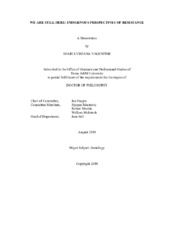| dc.description.abstract | In this qualitative study, I endeavor to tell the story of Indigenous resistance, particularly in North America. This story is told through interviews with more than 130 Indigenous activists from 29 Native nations who demonstrate the enduring and coherent nature of Indigenous resistance. I contend that the cultural matrix of Indigenous peoples serves as an abeyance organization to produce recurring activism that conforms to a coherent Indigenous worldview. This worldview produces movements which consistently prioritize protecting the land, centering spiritual principles, fostering community and featuring vital participation by women.
From the Ghost Dance ceremonies of the 1800s to the Water Protectors at Standing Rock, Indigenous peoples have resisted the dominant western paradigms. They have fought for a worldview that is not compatible with the white patriarchal domination of people and nature. This research illuminates an Indigenous worldview. What appears as an Indigenous “rhetoric of survivance” is actually deeply linked to a cultural, political and social epistemology with foundational and organic concepts like time, kinship structures and reciprocity – with concomitant “sacred civics” of “blood and responsibility” and a unique cosmology held in memory and trafficked orally.
Through annals and volumes of academic research across disciplines and cultures not only American Indians, but Indigenous peoples in general, remain marginalized. This marginalization takes place in a variety of ways. Often, it occurs as invisibility: there is simply no mention of Indigenous peoples. At other times, when Indigenous peoples appear, scholars caricature or romanticize them as an extinct species. This marginalization is expected inside mainstream discourses; it is more puzzling in discourses that fight oppression such as feminist theory or race theory. Frequently, Indigenous peoples are appropriated for discursive purposes and overlooked in the discussion of material realities and solutions. Examples from social movement theory, critical race theory and feminist theory serve to illustrate this pattern.
This research highlights the voices and ideas of Indigenous peoples to tell their own story in response to the marginalization and misrepresentation of usual academic discourse. | en |


